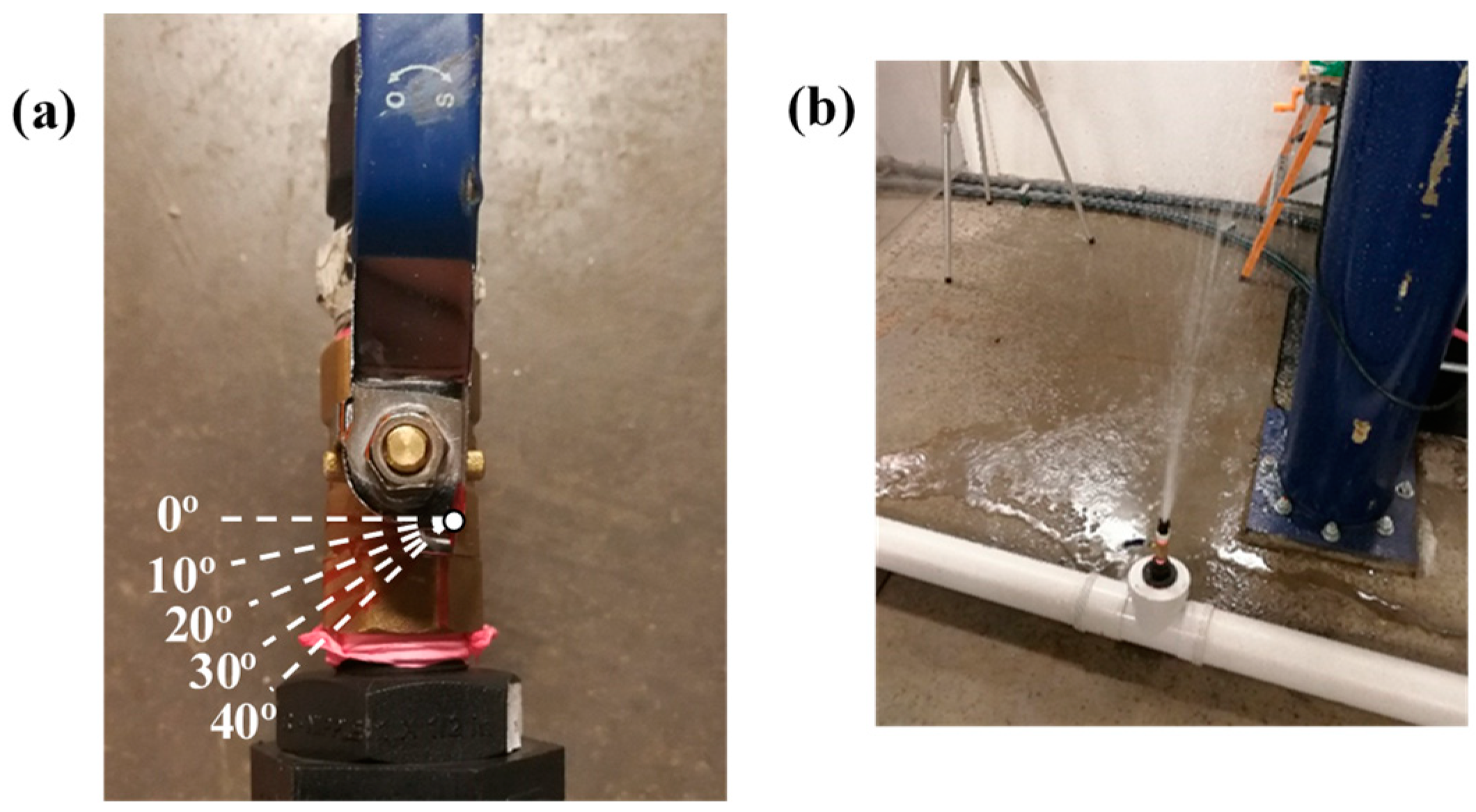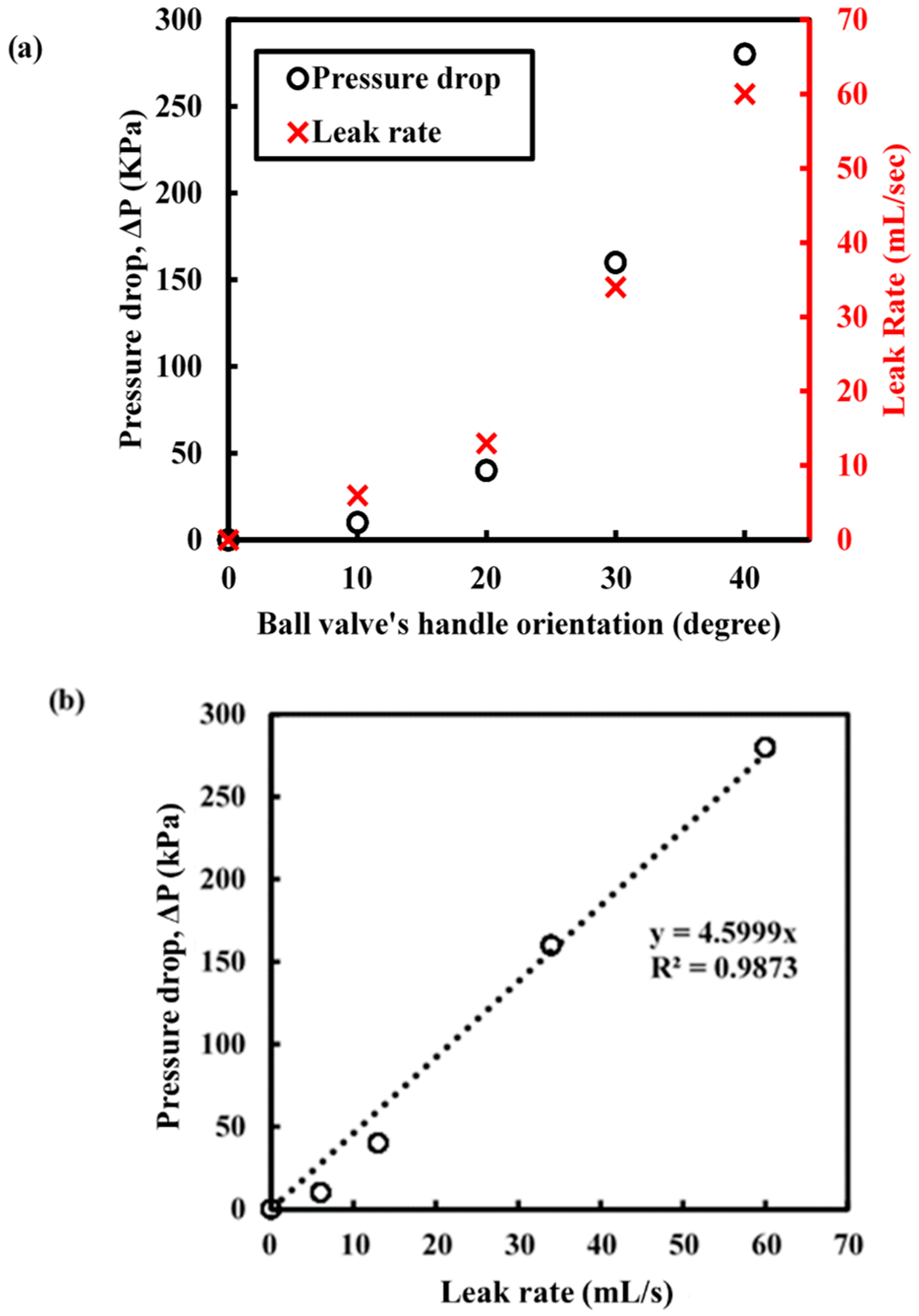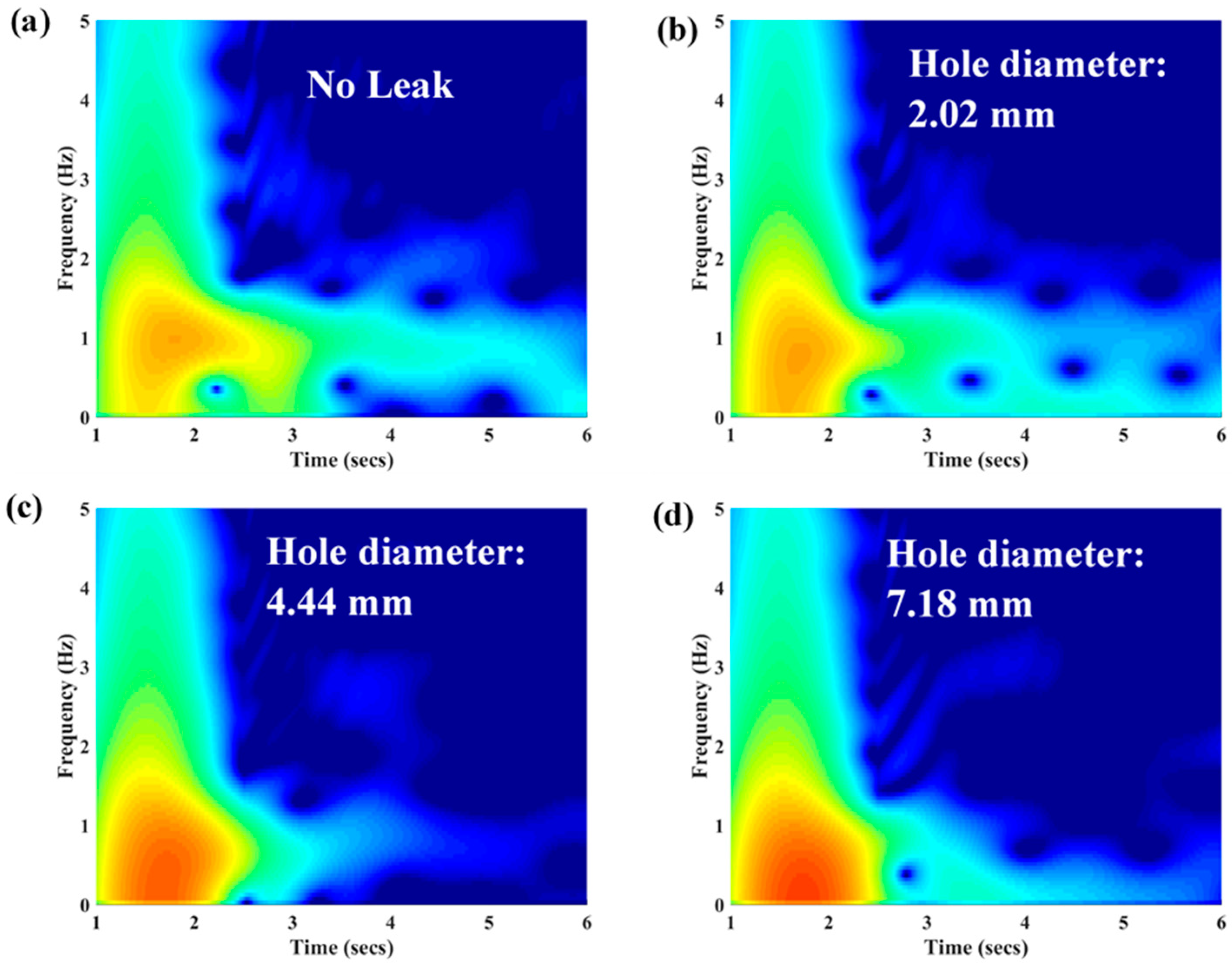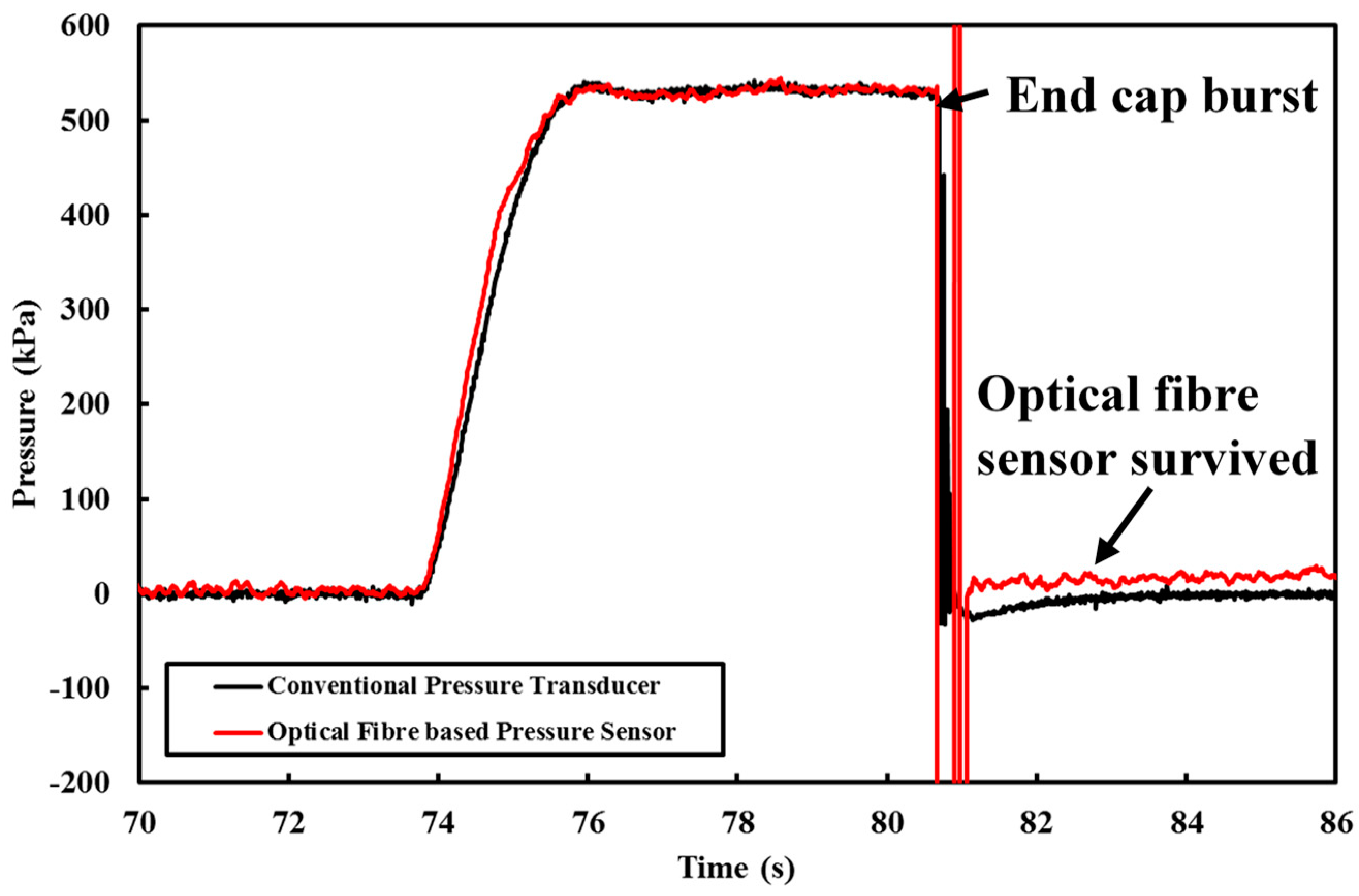Leak Detection in Water Pipes Using Submersible Optical Optic-Based Pressure Sensor
Abstract
:1. Introduction
2. Design of Submersible Optical Fibre-Based Pressure Sensor
3. Calibration Test
4. Potential Applications of the Submersible Optical Fibre-Based Pressure Sensors
- (i)
- Determine the operating condition of the pipe (from both steady and unsteady pressure occurring within the pipe section);
- (ii)
- Perform leak detection when the pipe was subjected to hydrostatic pressure;
- (iii)
- Perform leak detection when the pipe was subjected to pressure transients;
- (iv)
- And detect the presence of pipe fracture (pipe burst).
4.1. Monitoring Pipeline Operating Conditions
4.2. Pressure-Based Leak Detection
4.2.1. Static Leak Detection Technique (Hydrostatic Testing)
4.2.2. Transient-Based Leak Detection
4.3. Detection of Pipe Burst/Fracture
5. Conclusions and Future Plan
Author Contributions
Funding
Acknowledgments
Conflicts of Interest
References
- Rajeev, P.; Kodikara, J.; Chiu, W.K.; Kuen, T. Distributed optical fibre sensors and their applications in pipeline monitoring. Key Eng. Mater. 2013, 558, 424–434. [Google Scholar] [CrossRef]
- Inaudi, D. Long-gage fiber-optic sensors for structural monitoring. In Photomechanics; Springer: Berlin/Heidelberg, Germany, 2000; pp. 273–293. [Google Scholar]
- Glisic, B.; Inaudi, D. Fibre Optic Methods for Structural Health Monitoring; John Wiley & Sons: Hoboken, NJ, USA, 2008. [Google Scholar]
- Barrias, A.; Casas, J.R.; Villalba, S. A review of distributed optical fiber sensors for civil engineering applications. Sensors 2016, 16, 748. [Google Scholar] [CrossRef] [PubMed] [Green Version]
- Rao, Y.J. In-fibre Bragg grating sensors. Meas. Sci. Technol. 1997, 8, 355. [Google Scholar] [CrossRef]
- Wang, D.H.C.; Abbott, A.; Maunder, S.A.; Blenman, N.G.; Arkwright, J.W. A miniature fiber Bragg grating pressure sensor for in-vivo sensing applications. In Proceedings of the OFS2012 22nd International Conference on Optical Fiber Sensors, Beijing, China, 17 October 2012; International Society for Optics and Photonics: Bellingham, WA, USA, 2012; Volume 8421, p. 84213W. [Google Scholar] [CrossRef]
- Liang, Q.; Zou, K.; Long, J.; Jin, J.; Zhang, D.; Coppola, G.; Ge, Y. Multi-Component FBG-Based Force Sensing Systems by Comparison With Other Sensing Technologies: A Review. IEEE Sens. J. 2018, 18, 7345–7357. [Google Scholar] [CrossRef]
- Campanella, C.; Cuccovillo, A.; Campanella, C.; Yurt, A.; Passaro, V. Fibre Bragg Grating Based Strain Sensors: Review of Technology and Applications. Sensors 2018, 18, 3115. [Google Scholar] [CrossRef] [PubMed]
- Liu, W.; Guo, Y.; Xiong, L.; Kuang, Y. Fiber Bragg grating based displacement sensors: State of the art and trends. Sens. Rev. 2018. [Google Scholar] [CrossRef]
- Skels, P.; Janeliukstis, R.; Haritonovs, V. Review on structural health interrogation using fiber bragg grating sensors. In Proceedings of the 17th International Scientific Conference Engineering for Rural, Jelgava, Latvia, 23–25 May 2018. [Google Scholar]
- Palmieri, L.; Schenato, L. Distributed optical fiber sensing based on Rayleigh scattering. Open Opt. J. 2013, 7, 104–127. [Google Scholar] [CrossRef]
- Bao, X.; Chen, L. Recent progress in distributed fiber optic sensors. Sensors 2012, 12, 8601–8639. [Google Scholar] [CrossRef] [PubMed]
- Glisic, B. Sensing solutions for assessing and monitoring pipeline systems. In Sensor Technologies for Civil Infrastructures; Woodhead Publishing: Sawston, UK, 2014; pp. 422–460. [Google Scholar]
- Makhoul, N.; Limongelli, M.P.; Jaoude, R.A. Structural Health Monitoring of buried pipelines under seismic hazard: A reivew of damage scenarios and sensing techniques. In Proceedings of the 16th European conference on Earthquake Engeineering, Thessaloniki, Greece, 18–21 June 2018. [Google Scholar]
- Joe, H.E.; Yun, H.; Jo, S.H.; Jun, M.B.; Min, B.K. A review on optical fiber sensors for environmental monitoring. Int. J. Precis. Eng. Manuf. Green Technol. 2018, 5, 173–191. [Google Scholar] [CrossRef]
- Nikles, M. Long-distance fiber optic sensing solutions for pipeline leakage, intrusion, and ground movement detection. In Fiber Optic Sensors and Applications VI; International Society for Optics and Photonics: Bellingham, WA, USA, April 2009; Volume 7316, p. 731602. [Google Scholar]
- Lim, K.; Wong, L.; Chiu, W.K.; Kodikara, J. Distributed fiber optic sensors for monitoring pressure and stiffness changes in out-of-round pipes. Struct. Control Health Monit. 2016, 23, 303–314. [Google Scholar] [CrossRef]
- Inaudi, D.; Glisic, B. Integration of distributed strain and temperature sensors in composite coiled tubing. In Smart Structures and Materials 2006: Smart Sensor Monitoring Systems and Applications; International Society for Optics and Photonics: Bellingham, WA, USA, March 2006; Volume 6167, p. 616717. [Google Scholar] [CrossRef]
- Yasue, N.; Naruse, H.; Masuda, J.I.; Kino, H.; Nakamura, T.; Yamaura, T. Concrete pipe strain measurement using optical fiber sensor. IEICE Trans. Electron. 2000, 83, 468–474. [Google Scholar]
- Ding, Z.; Wang, C.; Liu, K.; Jiang, J.; Yang, D.; Pan, G.; Liu, T. Distributed optical fiber sensors based on optical frequency domain reflectometry: A review. Sensors 2018, 18, 1072. [Google Scholar] [CrossRef] [PubMed]
- Wong, L.; Lim, K.; Chiu, W.K.; Kodikara, J.; Chowdhury, N. Using water hammer to enhance the detection of stiffness changes on an out-of-round pipe with distributed optical-fibre sensing. Struct. Control Health Monit. 2017, 24, e1975. [Google Scholar] [CrossRef]
- Wong, L.; Chiu, W.K.; Kodikara, J. Using distributed optical fibre sensor to enhance structural health monitoring of a pipeline subjected to hydraulic transient excitation. Struct. Health Monit. 2018, 17, 298–312. [Google Scholar] [CrossRef]
- Wong, L.; Rathnayaka, S.; Chiu, W.K.; Kodikara, J. Fatigue Damage Monitoring of a Cast Iron Pipeline Using Distributed Optical Fibre Sensors. Procedia Eng. 2017, 188, 293–300. [Google Scholar] [CrossRef]
- Schenato, L.; Aneesh, R.; Palmieri, L.; Galtarossa, A.; Pasuto, A. Fiber optic sensor for hydrostatic pressure and temperature measurement in riverbanks monitoring. Opt. Laser Technol. 2016, 82, 57–62. [Google Scholar] [CrossRef]
- Ravet, F.; Briffod, F.; Niklès, M. Extended distance fiber optic monitoring for pipeline Leak and ground movement detection. In Proceedings of the 7th International Pipeline Conference, Calgary, AB, Canada, 29 September–3 October 2008; American Society of Mechanical Engineers: New York, NY, USA, 2008; pp. 689–697. [Google Scholar]
- Glisic, B.; Yao, Y. Fiber optic method for health assessment of pipelines subjected to earthquake-induced ground movement. Struct. Health Monit. 2012, 11, 696–711. [Google Scholar] [CrossRef]
- Higgins, M.S.; Paulson, P.O. Fiber optic sensors for acoustic monitoring of PCCP. In Proceedings of the Pipelines 2006: Service to the Owner, Chicago, IL, USA, 30 July–2 August 2006; pp. 1–8. [Google Scholar]
- Wu, H.; Sun, Z.; Qian, Y.; Zhang, T.; Rao, Y. A hydrostatic leak test for water pipeline by using distributed optical fiber vibration sensing system. In Proceedings of the Fifth Asia-Pacific Optical Sensors Conference, Jeju, Korea, 20–22 May 2015; Volume 9655, p. 965543. [Google Scholar]
- Liu, X.; Jin, B.; Bai, Q.; Wang, Y.; Wang, D.; Wang, Y. Distributed fiber-optic sensors for vibration detection. Sensors 2016, 16, 1164. [Google Scholar] [CrossRef] [PubMed]
- Miah, K.; Potter, D. A review of hybrid fiber-optic distributed simultaneous vibration and temperature sensing technology and its geophysical applications. Sensors 2017, 17, 2511. [Google Scholar] [CrossRef] [PubMed]
- Sounthararajah, A.; Wong, L.; Nguyen, N.; Bui, H.H.; Kodikara, J. Evaluation of flexural behaviour of cemented pavement material beams using distributed fibre optic sensors. Construct. Build. Mater. 2017, 156, 965–975. [Google Scholar] [CrossRef]
- Wong, L.; Chowdhury, N.; Wang, J.; Chiu, W.K.; Kodikara, J. Fatigue damage monitoring of a composite step lap joint using distributed optical fibre sensors. Materials 2016, 9, 374. [Google Scholar] [CrossRef] [PubMed]
- Liu, Z.; Kleiner, Y. State of the art review of inspection technologies for condition assessment of water pipes. Measurement 2013, 46, 1–15. [Google Scholar] [CrossRef] [Green Version]
- Shi, H.; Gong, J.; Arkwright, J.W.; Papageorgiou, A.W.; Lambert, M.F.; Simpson, A.R.; Zecchin, A.C. Transient pressure measurement in pipelines using optical fibre sensor. In Proceedings of the Australian and New Zealand Conference on Optics and Photonics 2015 (ANZCOP 2015), Adelaide, Australia, 29 November–3 December 2015; Volume 55. [Google Scholar]
- Stephens, M.L.; Lambert, M.F.; Simpson, A.R. Determining the internal wall condition of a water pipeline in the field using an inverse transient. J. Hydraulic Eng. 2012, 139, 310–324. [Google Scholar] [CrossRef]
- Colombo, A.F.; Lee, P.; Karney, B.W. A selective literature review of transient-based leak detection methods. J. Hydro-Environ. Res. 2009, 2, 212–227. [Google Scholar] [CrossRef]
- Gong, J.; Lambert, M.F.; Simpson, A.R.; Zecchin, A.C. Single-event leak detection in pipeline using first three resonant responses. J. Hydraulic Eng. 2012, 139, 645–655. [Google Scholar] [CrossRef]
- Ramos, H.; Covas, D.; Borga, A.; Loureiro, D. Surge damping analysis in pipe systems: Modelling and experiments. J. Hydraulic Res. 2004, 42, 413–425. [Google Scholar] [CrossRef]
- Wang, X.J.; Lambert, M.F.; Simpson, A.R. Detection and location of a partial blockage in a pipeline using damping of fluid transients. J. Water Resour. Plan. Manag. 2005, 131, 244–249. [Google Scholar] [CrossRef]
- Wang, X.J.; Lambert, M.F.; Simpson, A.R.; Liggett, J.A.; Vıtkovský, J.P. Leak detection in pipelines using the damping of fluid transients. J. Hydraulic Eng. 2002, 128, 697–711. [Google Scholar] [CrossRef]
- Gong, J.; Png, G.M.; Arkwright, J.W.; Papageorgiou, A.W.; Cook, P.R.; Lambert, M.F.; Zecchin, A.C. In-pipe fibre optic pressure sensor array for hydraulic transient measurement with application to leak detection. Measurement 2018, 126, 309–317. [Google Scholar] [CrossRef]
- Rathnayaka, S.; Shannon, B.; Rajeev, P.; Kodikara, J. Monitoring of pressure transients in water supply networks. Water Resour. Manag. 2016, 30, 471–485. [Google Scholar] [CrossRef]
- Rathnayaka, S.; Shannon, B.; Robert, D.; Kodikara, J. Experimental evaluation of bursting capacity of corroded grey cast iron water pipeline. Struct. Infrastruct. Eng. 2017, 13, 1553–1562. [Google Scholar] [CrossRef]
- Wong, L.; Deo, R.; Rathnayaka, S.; Shannon, B.; Zhang, C.S.; Kodikara, J.; Chiu, W.K.; Widyastuti, H. Leak detection and quantification of leak size along water pipe using optical fibre sensors package. Electron. J. Struct. Eng. 2018, 18, 47–53. [Google Scholar]
- Wong, L.; Deo, R.; Rathnayaka, S.; Shannon, B.; Zhang, C.S.; Kodikara, J.; Chiu, W.K.; Widyastuti, H. Water pipe condition assessment using submersible quasi-distributed optical fibre based pressure transducers. Electron. J. Struct. Eng. 2018, 18, 54–60. [Google Scholar]
















| Type of Information | Description |
|---|---|
| Maximum sensing length | 10 m |
| Maximum data acquisition rate | 100 Hz |
| Gauge length | 5.12 mm |
| Strain resolution | 1 µε |
| Strain repeatability | ±5 µε |
| Temperature resolution | 0.1 °C |
| Temperature repeatability | ±0.4 °C |
© 2018 by the authors. Licensee MDPI, Basel, Switzerland. This article is an open access article distributed under the terms and conditions of the Creative Commons Attribution (CC BY) license (http://creativecommons.org/licenses/by/4.0/).
Share and Cite
Wong, L.; Deo, R.; Rathnayaka, S.; Shannon, B.; Zhang, C.; Chiu, W.K.; Kodikara, J.; Widyastuti, H. Leak Detection in Water Pipes Using Submersible Optical Optic-Based Pressure Sensor. Sensors 2018, 18, 4192. https://doi.org/10.3390/s18124192
Wong L, Deo R, Rathnayaka S, Shannon B, Zhang C, Chiu WK, Kodikara J, Widyastuti H. Leak Detection in Water Pipes Using Submersible Optical Optic-Based Pressure Sensor. Sensors. 2018; 18(12):4192. https://doi.org/10.3390/s18124192
Chicago/Turabian StyleWong, Leslie, Ravin Deo, Suranji Rathnayaka, Benjamin Shannon, Chunshun Zhang, Wing Kong Chiu, Jayantha Kodikara, and Hera Widyastuti. 2018. "Leak Detection in Water Pipes Using Submersible Optical Optic-Based Pressure Sensor" Sensors 18, no. 12: 4192. https://doi.org/10.3390/s18124192





